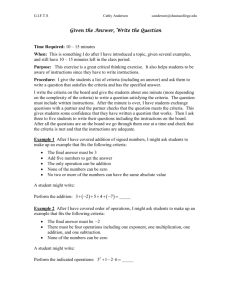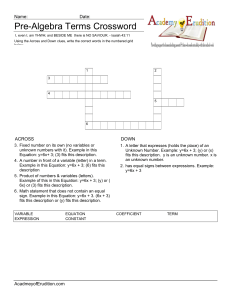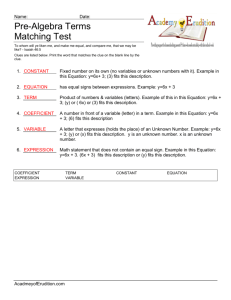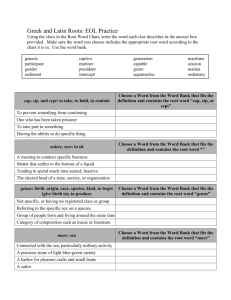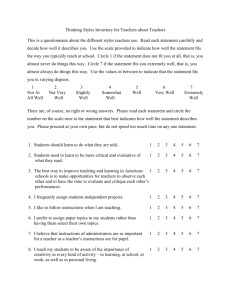SDO EVE Science Data Processing Workshop Data Processing Status Don Woodraska
advertisement
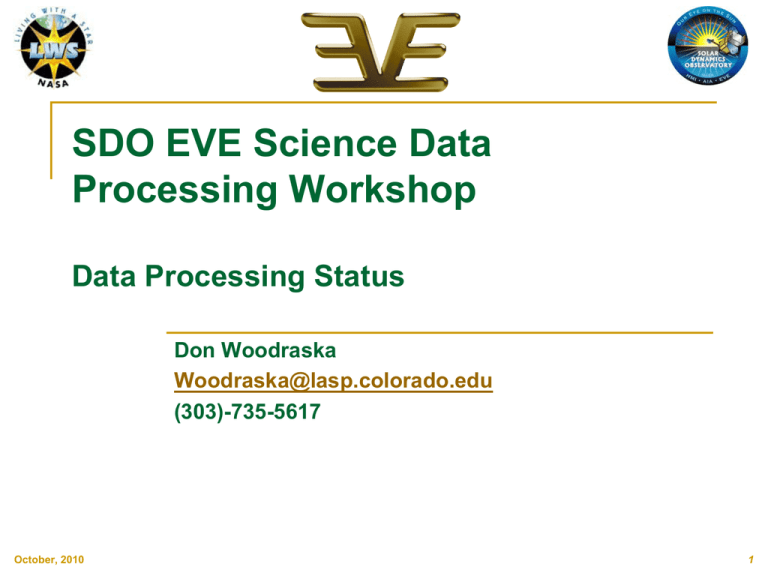
SDO EVE Science Data Processing Workshop Data Processing Status Don Woodraska Woodraska@lasp.colorado.edu (303)-735-5617 October, 2010 1 Science Product Subsystem Overview Legend Code DDS Ka-band TLM data to SPOC Level 0A Level 0A to 0C are “time-critical” space weather data flow Level 0CS data flow is much Test Patterns fastest Levels 1-3 are not near-RT Public Products Level 0C Primary are 0C, 0CS, 1, 2, & 3 VCDU files Level 0A Data Reprocessing Level 0B IOC ENG Level 0B Level 1 Level 0D Level 0D Level 0C Level 2 RT Photo. Level 0CS Data Dissemination Subsystem Level 2 Level 3 October, 2010 SAM only S-band TLM data from IOC Level 1 Cal data FOV & Cruciforms, Flatfields, Darks, Higher Orders, etc Level 3 2 Processing Levels Level Description Span Type 0A (TLM) Unprocessed VCDUs (packets) – files received from DDS ~1 min binary 0B Assembled/merged integrations separated by channel ~1 min FITS 0C Space weather (Ka-band) – all channels available in Latest and Daily files 15 min & 1 day ASCII 0CS Space weather (S-band) – lowest latency, only diodes and proxies Same ASCII 0D Daily merged 0B data with duplicates removed 1 day FITS 1 Irradiance for each channel (no degradation applied to spectra) 1 hour FITS 1A SAM only, event list 1 day FITS 1B SAM only, spectrum (cadence is TBD) Same FITS 2-EVS Merged, degradation corrected MEGS-A and B level 1 spectra with MEGS-B sampling (.02 nm) 1 hour FITS 2-EVL Extracted lines and bands, averaged diodes to match spectrum timestamp, proxies (same as 0C) Same FITS 3 Daily average spectrum at 0.02 nm 1 day FITS 3 Daily average 0.1 nm spectrum 1 year 3 Daily average 1 nm spectrum Mission FITS/S AV/ASC II? October, 2010 3 Processing Hardware Status Level 0C hardware is built for minimizing downtime due to failures What has broken DS3, redundant interface servers, 48 node compute cluster, cold-spare disk controller, redundant head nodes, cold spare network switches, redundant file servers, RAID arrays, redundant fiber channel switches, redundant web servers, redundant load balancers, tape library with redundant drives Network switch, ~12 disks, ~5 nodes (2 are down now), 1 RAID controller, 1 tape Level 0CS hardware has single string elements October, 2010 Rebroadcast S-band uses engineering server for socket connection, and one workstation (hot spare workstation available) EVE Science Processing Workshop, Woodraska 4 Processing Software Status All processing software (except level 3, and the SpWx spectrum) are operational Version 1 products were released June 18, 2010 Version 2 October, 2010 Uncertainties missing Known issues with degradation Bake-outs cause spectrum jumps MEGS-B portion of spectrum is usually missing because of reduced exposure operations Energetic particles affect spectra at Anticipated before AGU EVE Science Processing Workshop, Woodraska 5 EVE-SOC Interface Overview SDO in Geosynchronous Orbit MOC at GSFC DDS at WSC near-RT science data files (Ka-band) RT HK (S-band) Handshake files Retransmitted science data files RT HK (S-band) Commands Daily HK file Planning data Retransmissions EVE SOC at LASP SPOC ENG Data IOC RT HK WWW October, 2010 USC 6 Routine Data Products - 1 Level 1 ESP Development is the responsibility of USC, LASP only runs their software Contains every quarter-second integration with the best calibration No averaging is performed FITS file contains data spanning 1 UT day from midnight to midnight Cadence: daily Latency: >14 hours Development status: version 1 released, version 2 in progress Level 1 MEGS-P Contains every quarter-second integration with best calibration File type, cadence, latency the same as Level 1 ESP Development status: version 1 released October, 2010 No averaging is performed Version 2 may have no significant differences except for completeness 7 Routine Data Products - 2 Level 2 – Spectrum Contains 0.02 nm sampled merged spectra (5 samples/resolution element) FITS files span 1 UT hour (~17 MB each) Latency: >14 hours No averaging is performed Uncompressed size is ~400 MB / day (compresses to ~50) Available around 11 AM MT for the previous day Development status: version 1 released Version 2 will include October, 2010 Degradation corrections Flatfield burn-in Initial “first-light” degradation MEGS-A slit 2 filter degradation Uncertainties (hopefully) 8 Routine Data Products - 3 Level 2 – Lines/Bands/Diodes Contains time-averaged ESP & MEGS-P to match the spectra Contains integrated lines and broad bands from the spectra FITS files span 1 UT hour Development status: version 1 released Additional derived data Sometimes 10-second data is too much Calculates 1-minute avg of lines/bands/diodes Web services October, 2010 Results stored in database Allows direct comparison with GOES XRS (not included) Machine-service to return CSV (ASCII) data for one-band in one day increments Plot service to view long-time series 9 Routine Data Products - 4 Level 3 – Spectrum Daily-average product Merged spectrum average (6-105 nm) at 0.02 nm SAM spectrum average (0.1-6 nm) Photometer averages File formats 0.02 nm sampled FITS file will span 1 UT year Auxiliary FITS files created from the primary file 0.1 nm integrated FITS file 1.0 nm integrated FITS file Can also create ASCII, netCDF, or IDL sav format from above files Data will be made available through LISIRD (after validation) Cadence: daily updates to yearly files Latency: <36 hours Development status: 0% complete October, 2010 One row appended per day Similar size to a one hour Level 2 spectrum file Estimate 4 weeks effort to complete (lots of heritage) 10 Data Processing Timing and Version Numbering Routine reprocessing After 30 days, processing is repeated Holes are filled, we have all the data we will ever get Calibration/degradation corrections can be interpolated, higher quality products New Version release reprocessing When significant changes are made to the calibration corrections, or processing algorithms that impact the quality of the data, a new processing version number is created. Requires regenerating the entire mission Version Plan is subject to change October, 2010 The majority of compute time is spent doing this. Version 1 is the first release Version 2 is expected after the first rocket calibration is applied (AGU) Version 4 is expected after the 2nd or 3rd rocket calibration is applied (L+12 months) Other versions… 11 Extracted Lines Wavelength (nm) Log T Ion Wavelength (nm) Log T Ion 9.39 6.81 Fe XVIII 46.52 5.71 Ne VII 13.12 5.57 Fe VIII 49.94 6.29 Si XII 13.29 6.97-7.16 Fe XX Fe XXIII 52.58 4.92 O III 17.11 5.81 Fe IX 55.44 5.19 O IV 17.72 5.99 Fe X 58.43 4.16 He I 18.04 6.07 Fe XI 59.96 4.92 O III 19.51 6.13 Fe XII 62.49 6.05 Mg X 20.20 6.19 Fe XIII 62.97 5.37 OV 21.13 6.27 Fe XIV 71.85 4.48 O II 25.63 4.75 He II 77.04 5.81 Ne VIII 28.42 6.30 Fe XV 79.02 5.19 O IV 30.38 4.70 He II 97.25 3.84 HI 33.54 6.43 Fe XVI 97.70 4.84 C III 36.08 6.43 Fe XVI 102.57 3.84 HI 36.81 5.99 Mg IX 103.19 5.47 O VI October, 2010 Fe series: VIII-XVI, XVIII, XX O series: II-VI 12 Data File Details All data products are either ASCII or FITS Reader software ASCII files are readable by any text reader Some may have very long lines, where each line pertains to one date/time FITS standard readers FV (FITS View) is a graphical tool for opening/editing FITS files IDL software packages are available from several sources (like SolarSoft) EVE processing uses high-level mrdfits.pro/mwrfits.pro available from the GSFC IDL Astronomy Library (we also use the low-level cfitsio library) Rather than treating metadata (like time, date, resolver, etc) as ASCII strings that need to be extracted from the header, it is also included with the data and treated like data Level 1-3 files are all FITS Files contain an empty primary HDU (for compatibility), and binary tables A row in the table corresponds to a time Columns are data fields (scalars or arrays, no pointers, no objects, no structures) Each row pertains to one date/time October, 2010 http://idlastro.gsfc.nasa.gov/fitsio.html Header keywords are increasingly used http://heasarc.gsfc.nasa.gov/ftools/fv/ Fixed length? 8639-8641 variable number of integrations depending on clock drift, power cycles, Ka-comm switches, etc. 13 Summary Version 2 is planned to be released before AGU (Dec) EVE SPOC contains sufficient hardware redundancy to produce products under most common failure scenarios EVE science processing will create files with several latencies File formats are ASCII and FITS Many standard readers exist for FITS, we use mrdfits.pro and fv Level 2 maintains the instrument spectral resolution Availability ranges from seconds to 30+ days Time cadence is maintained for CCD data Online accessible database October, 2010 One for daily average data (LISIRD) One for 1-minute samples of lines/bands/diodes 14
